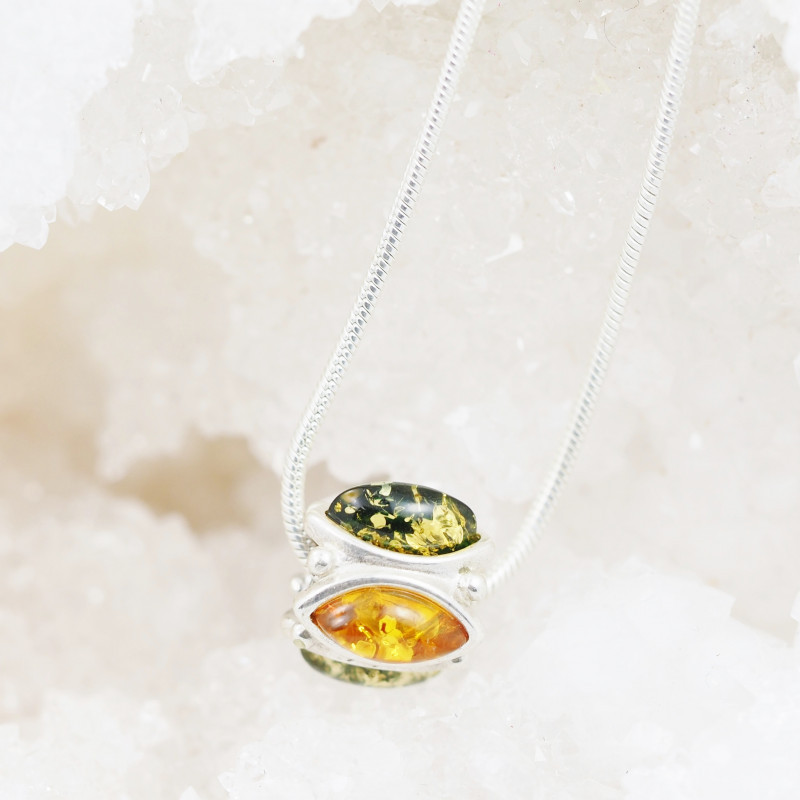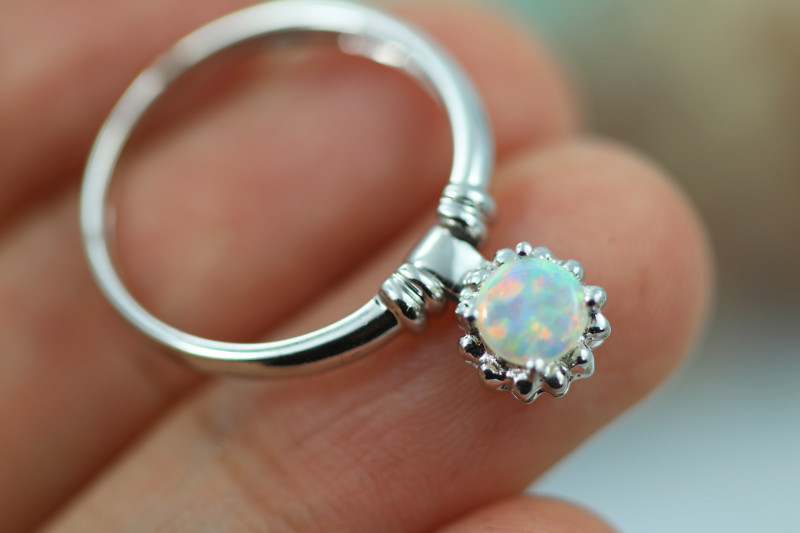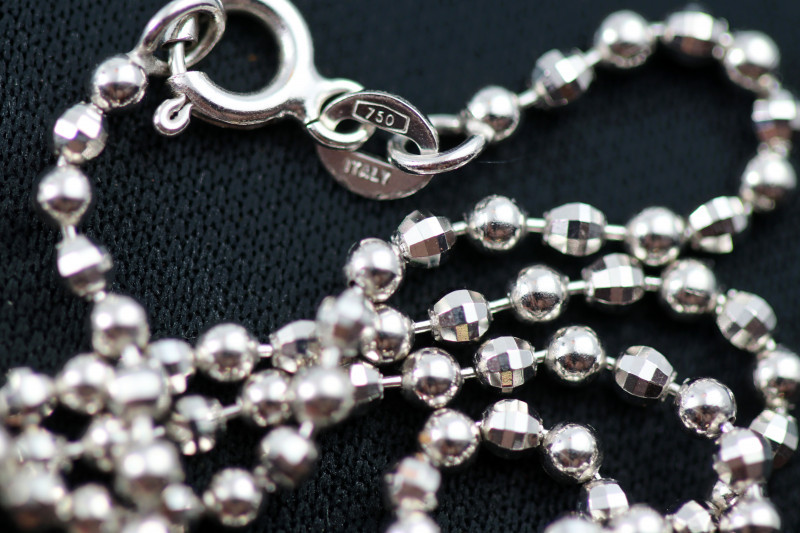
White Gold vs Silver: A Complete Guide To Help You Decide!
 There’s nothing as timeless and elegant as silver-colored jewelry. White gold and silver are so popular, many people struggle to decide between them! Because people commonly mix up these metals, we will compare white gold vs silver in this complete guide.
There’s nothing as timeless and elegant as silver-colored jewelry. White gold and silver are so popular, many people struggle to decide between them! Because people commonly mix up these metals, we will compare white gold vs silver in this complete guide.
Aside from similarities in color, the two are entirely different. One contains pure gold, while the other has pure silver. One metal is more expensive, and the other is a cost-effective choice.
White gold and silver are both popular precious metals, so which will you choose? Keep reading to learn more about white gold vs silver to help you make the best choice for your jewelry!
The first order of business: let’s get clear on each metal’s composition.

White Gold vs Silver Composition
As you might suspect, each of these metals is natural and pure. Both silver and white gold contain high purity levels, but they are much too soft to hold their own in jewelry. That’s why each one has added alloys to make them more durable.
Silver
Silver is a natural element; however, it’s much too soft for jewelry metals because it can easily damage or change shape. The solution to this is to add alloy metals like zinc, copper, or nickel. Adding alloys strengthens the metal to make it durable for daily wear.
The purest silver is 99.9%, which is typically reserved for fine jewelry like engagement rings. You might wonder: is all silver sterling silver? Not quite. Sterling silver has a 92.5% purity and is the most popular form of silver jewelry metal.
If you want to identify sterling silver, look for one of the following hallmark stamps:
.925 or 925
STER
STG
Sterling Silver
STERLING

White Gold
White gold doesn’t exist naturally because it’s alloy metal. This isn’t to insinuate it’s synthetic, as it contains pure yellow gold plated in white rhodium. The most common composition of white gold is yellow gold mixed with silver and copper. Adding these metals creates a more durable and long-lasting material.
White gold will always have at least 50% pure yellow gold. You can tell the purity of white gold jewelry by looking for the hallmark of one of the following stamps:
.750 = 18K gold
.587 = 14K gold
.417 = 10K gold
Some white gold contains nickel, which does increase the metal’s durability. But there’s a caveat: nickel is a known allergen that’s not conducive to all skin types.
Key Takeaways on White Gold vs Silver Composition:
Purity: Both metals are relatively pure, but each has added elements to make them stronger.
Allergens: Both metals may contain nickel, a known allergen. However, white gold is less likely to contain nickel because it’s most commonly mixed with silver and copper. If you have sensitive skin, ask your jeweler for a full breakdown of the composition to ensure it doesn’t have nickel.

 Pictured above: Top - Rhodium-plated white gold rings | Bottom - Sterling silver chain
Pictured above: Top - Rhodium-plated white gold rings | Bottom - Sterling silver chain
White Gold vs Silver Color Difference
One of the essential factors to engagement ring shoppers is color, and rightfully so. You’ll wear your ring forever, and you want to be head over heels in love with the color. Honestly, both of these metals have similar coloring, so how can you tell the difference between white gold vs silver?
Silver Color
The color of silver correlates with its composition. As mentioned above, silver is mostly pure with the addition of alloy metal. The overall look is a shiny, white, lustrous metal. As polished as it may be, it’s not quite as brilliant or bright as white gold. However, silver will typically be more affordable than white gold.
White Gold Color
People desire white gold for one primary factor: its brilliant white color. Try as it might, silver will never quite shine as brightly as white gold, which is why white gold tends to be more pricey. This comes at a cost because white gold depends on rhodium plating to add an extra layer of shine. The rhodium plating also elongates white gold’s lifespan, making it a substantial investment for engagement rings and wedding bands.
Key Takeaways of White Gold vs Silver Color
The difference between these two metals' coloring is slight, but it can be a large factor for many buyers.
White gold is brighter and more lustrous than silver, but more expensive.
Silver is a beautiful, bright color, but it doesn’t have that signature brilliance seen in white gold. Fortunately, it makes up in affordability what it slightly lacks in color.
 Pictured above: Sterling silver necklace
Pictured above: Sterling silver necklace
What Lasts Longer: Sterling Silver or White Gold?
The factors that make white gold and silver unique influences its overall value and intrigue. One of the most important things to consider when purchasing fine jewelry made with precious metals is its lifespan. You certainly don’t want to invest in jewelry only to have it fall apart after a few years.
In their purest form, both silver and gold are incredibly soft and malleable. If alloy metals aren’t added, they’ll easily damage and change shape when exposed to harder surfaces like diamonds or countertops.
Fortunately, both white gold and sterling silver are highly durable, but there are essential things to consider about each one.
Silver Durability
Silver alone isn’t strong enough to withstand the daily wear and tear of jewelry items — especially engagement rings. That’s why sterling silver is typically the optimal choice for jewelry. The addition of metals like zinc and copper substantially increases the metal’s durability and strength.
With this in mind, it’s smartest to choose sterling silver jewelry if you want it to hold up long-term. Additionally, sterling silver doesn’t easily scratch or tarnish. If you practice routine maintenance and cleaning, your silver jewelry will shine throughout your lifetime.
How does white gold stack up?
White Gold Durability
Compared to yellow gold, white gold is built to last. Thanks to the protective rhodium plating, white gold is highly resistant to scratches. Of course, this is entirely contingent upon the karatage you choose for your jewelry.
The strongest, most durable variation of white gold will be the lowest karatage because it contains the highest alloy metal concentration.
For instance, 14K white gold contains 58.5% pure gold, with the remaining 42.5% being copper, zinc, and/or nickel.
By contrast, 18K white gold has 75% pure gold, with the remaining 25% containing an alloyed blend, including silver.
Which do you think is most durable? If you guessed 14K gold, you’re right, because it has less pure gold and more durable alloys.
Key Takeaways of White Gold vs Silver Durability
Ultimately, both metals are quite durable, but it depends on the purity of gold or silver.
The higher the karatage of white gold, the less durable it is, so if you work with your hands, you may want to choose sterling silver or 14K white gold.
Silver isn’t a strong metal, but sterling silver is highly durable.
Both metals require routine maintenance and ongoing care to preserve the lifespan and quality of your jewelry.
Now, let’s talk about value, one of the most important factors when choosing between white gold vs silver jewelry.
 Pictured above: White gold ring with crystal opal
Pictured above: White gold ring with crystal opal
Value: White Gold vs Silver
Let’s talk about the commonalities between white gold and silver jewelry. First of all, they both fall into the precious metals category. Precious metals are prime selections for jewelry because they are high-quality, durable, and long-lasting.
If they are equitable in these areas, shouldn’t they cost about the same? Well, we have to consider that white gold contains pure gold, which generally is more valuable than silver.
As such, silver jewelry is cost-effective and more budget-friendly than white gold, despite them both being precious metals.
And then there’s the prestigious factor to consider. Silver jewelry is most often used for fashion jewelry, whereas white gold is reserved for fine jewelry items like engagement rings. Of course, value changes with the generations, and at one point, silver was much more valuable than gold. Currently, white gold is a great price point because it’s more affordable than platinum, and they look the same to the eye.
You also have to consider gold purity. For example, if you buy 10K white gold, it contains only 41.7% of pure gold. This means that there is more alloy in the metal than actual pure gold. Compared to sterling silver, which has 92.5% of pure silver, 10K white gold doesn’t quite stack up. Add more pure gold to the mixture, and the value goes up.
Key Takeaways of White Gold vs Silver Value
The higher the gold purity, the higher the value of white gold.
A white gold engagement ring will be more expensive than its silver counterpart, even if the styles are similar.
Gold tends to appreciate better than silver, so white gold is a better long term investment.
We’ve covered the basics of white gold vs silver, and it’s clear that there are many similarities and differences between the two. Ultimately, they look similar to the eye despite their differences. So, how can you tell them apart?
 Pictured above: 18K Italian white gold with "750" hallmark
Pictured above: 18K Italian white gold with "750" hallmark
How To Tell White Gold From Silver
It helps to have a visual reference to differentiate between white gold and silver. After all, the two colors are so close, it’d be easy to mix them up. With these key tips, you’ll be able to tell white gold from silver with a quick scan.
Silver tends to show tarnishing more than white gold.
If you see any white or gray discoloration on the surface, there’s a strong chance it’s silver.
When in doubt, look for hallmarks.
Sterling silver and white gold each have their stamps, and every real jewelry metal will have a hallmark. If you see “750” or “14K”, then the item contains 14 karats of pure gold, no matter if it’s white, yellow, or rose gold. Conversely, if you see an inscription reading “.925” or “STER,” then it’s sterling silver.
Does the ring have gemstones?
If so, it’s likely white gold as most sterling silver won’t have elaborate or expensive settings. To verify, check the hallmark or ask the jeweler.
White Gold vs Silver: Which is Better?
We’ve covered a lot in this article, but perhaps you’re still unsure which is right for you. Ultimately, choosing between white gold and silver depends on what type of jewelry you’re buying. There are pros and cons to each metal, and what might work for an engagement ring might not be optimal for a pendant, and vice versa.
Let’s do a quick recap of each metal to help nudge you toward your choice.
Silver - Why You Should Buy It
If you’re looking for affordable, pure jewelry that’s hypoallergenic, silver is a great option. You might want to choose silver for your earrings, rings, necklace chains, and pendants. Of course, silver requires much more maintenance to preserve the finish and avoid tarnishing. Over time, silver can discolor. However, if you clean your jewelry often, it’ll look beautiful long-term.
White Gold - Why You Should Buy It
First and foremost: white gold is an investment. It’s more expensive than silver jewelry, but there’s a reason for that. White gold is more durable, hypoallergenic, and long-lasting. If you’re buying an engagement ring or wedding band, white gold is going to be the better choice because it holds more value, durability, and lifespan. If you plan to pass down your jewelry through generations, you might want to splurge and get the white gold.
The Bottom Line
The intrigue of buying jewelry is getting to personalize your choices to your lifestyle and preferences. You can’t go wrong with either of these precious metals, but it depends on how you plan to wear your jewelry. Ultimately, there’s a reason these are two of the most famous jewelry metals in the market: they’re timeless, durable, and versatile.
We hope this comparison of white gold vs silver helped you make an informed decision that best suits your desires.
If you need a little more inspiration, browse our collection of white gold and silver jewelry while you’re here!
Search the Fashion Encyclopedia
Related Auctions
Related Articles
How to Buy Jewelry on the Internet. There are so many types of beads. It will be up to you to determine where you want to start, all authentic gemstone beads or if you will also use glass beads ‘man made’ as well as gold and silver beading. You
10th Apr 2019
How to buy a ruby for your ring or pendant,Make sure that you learn as much as you can about Rubies, prior to buying a ring or a setting that you are going to add Rubies to. Like Diamonds, Rubies can be flawed, and imperfect The Ruby is one of the most b
10th Apr 2019
Latest Articles
Titanium is a popular jewelry metal known for being lightweight, durable, and affordable. Learn all about titanium, how it compares to similar metals, and the pros and cons of titanium jewelry.
7th Feb 2023
Learn all about tungsten jewelry - from its history and uses to its durability and care. By the end of our guide, you’ll know if tungsten is right for you!
7th Feb 2023
Thinking about adding some timeless white gold jewelry to your fine accessories collection? Here’s all there is to know about sophisticated white gold!
29th Jan 2023








